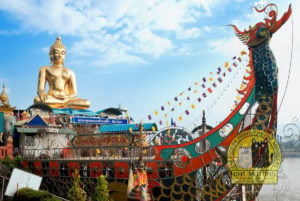Chiang Mai’s Bus Stations: A Stress-Free Guide
Hey there, fellow wanderers! So, you’ve just landed at the Chiang Mai Bus Station, huh? That’s awesome! You’re standing right at the heart of Northern Thailand – the launchpad for some of the most thrilling adventures you’re ever going to have! This isn’t your everyday bus station, oh no. It’s a lively, bustling hub that zings with the energy of travelers, just like you, who are all set to dive head-first into the wonders of Chiang Mai.
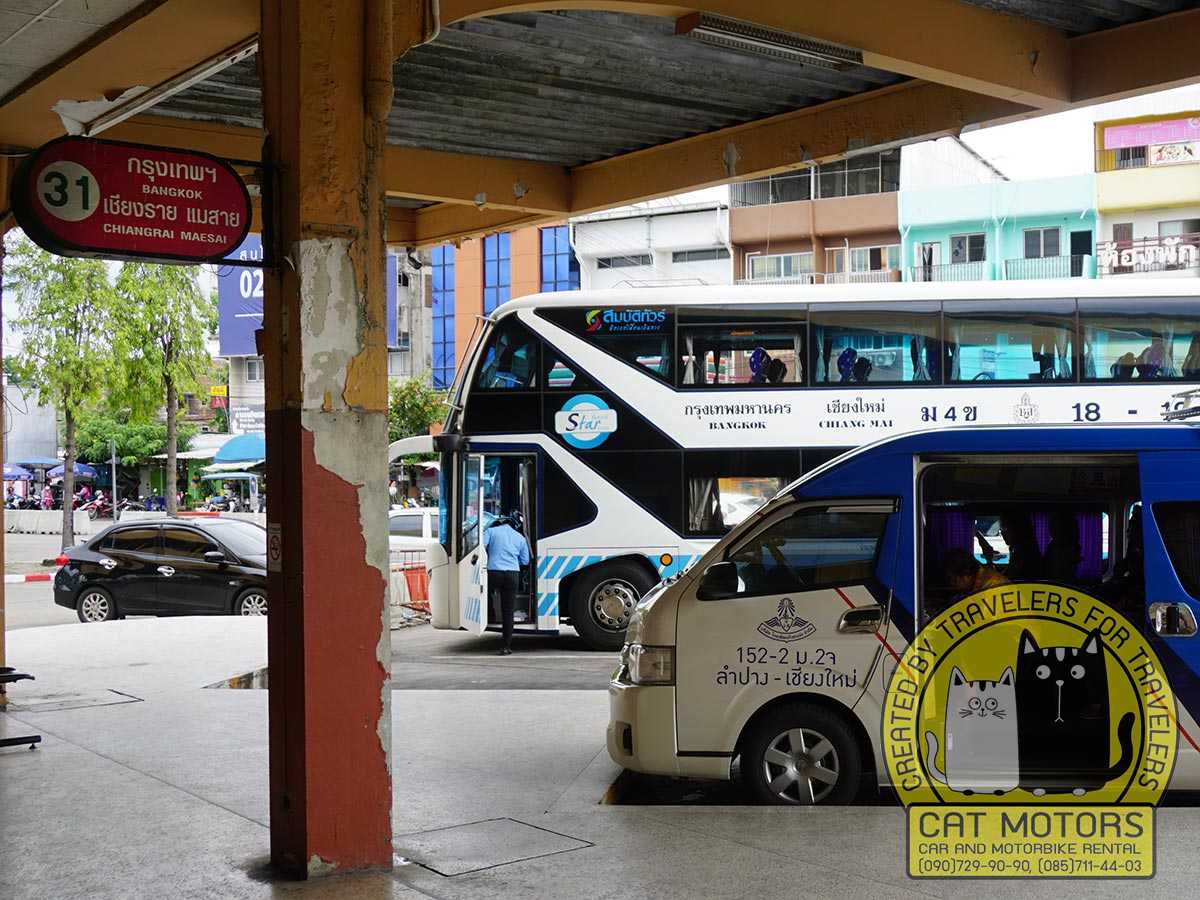
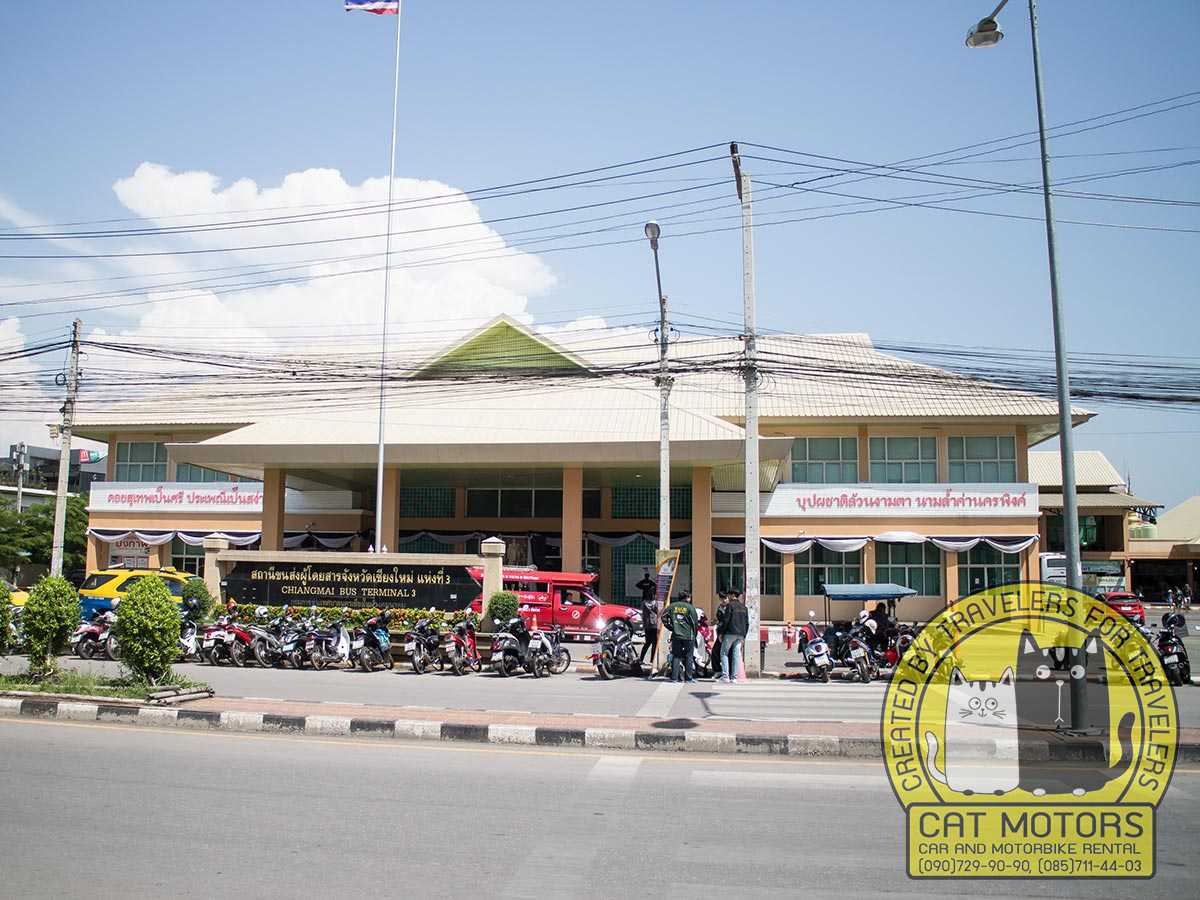
Getting To Chiang Mai Bus Station: Location And Accessibility
Chiang Mai has three main bus stations that serve different purposes and destinations. The one closest to the city center is Chiang Mai Bus Terminal 1 (Chang Phueak Bus Station), which only runs around public areas around the city’s nearby districts within the province and city, like Chiang Mai to Pai.
It is situated just north of the old city moat, next to a grocery store called “Yao Seasoning Shop” (ร้านเหยาเครื่องปรุง瑶调味料). You can access this terminal by car or other means of public transportation.
But for long-distance travelers, you would want to focus on the Chiang Mai bus terminals 2 & 3, located east of the city center, right by Prempracha Transport Co., Ltd. (Chiangmai Bus Terminal 2, Arcade Bus station). These terminals cater to long-distance express buses to and from Chiang Mai and other parts of Thailand.

To help you get a better sense, the following are some directions to the bus station terminal 1 from various common locations in Chiang Mai:
- From the airport: The airport is about 6.1 kilometers (3.7 miles) southwest of the bus station. You can take a songthaew for about 40-50 THB per person, which should take about 15 minutes.
- From the train station: The train station is located about 4 kilometers (2.5 miles) south of the bus station. You can hail a songthaew for about 30-40 THB per person, and it should also take about 10 minutes to get there.
- From the old city: Located about 3 kilometers (1.9 miles) west of the bus station, you can take a taxi from the old city for about 80-120 THB or a songthaew for about 20-30 THB per person and should take about 10 minutes.
- From Nimman Road: If you want to enjoy some shopping, dining, and nightlife in Chiang Mai, Nimman Road is a great place to go. It’s about 2.8 kilometers (1.7 miles) away from the bus station in the northwest direction.
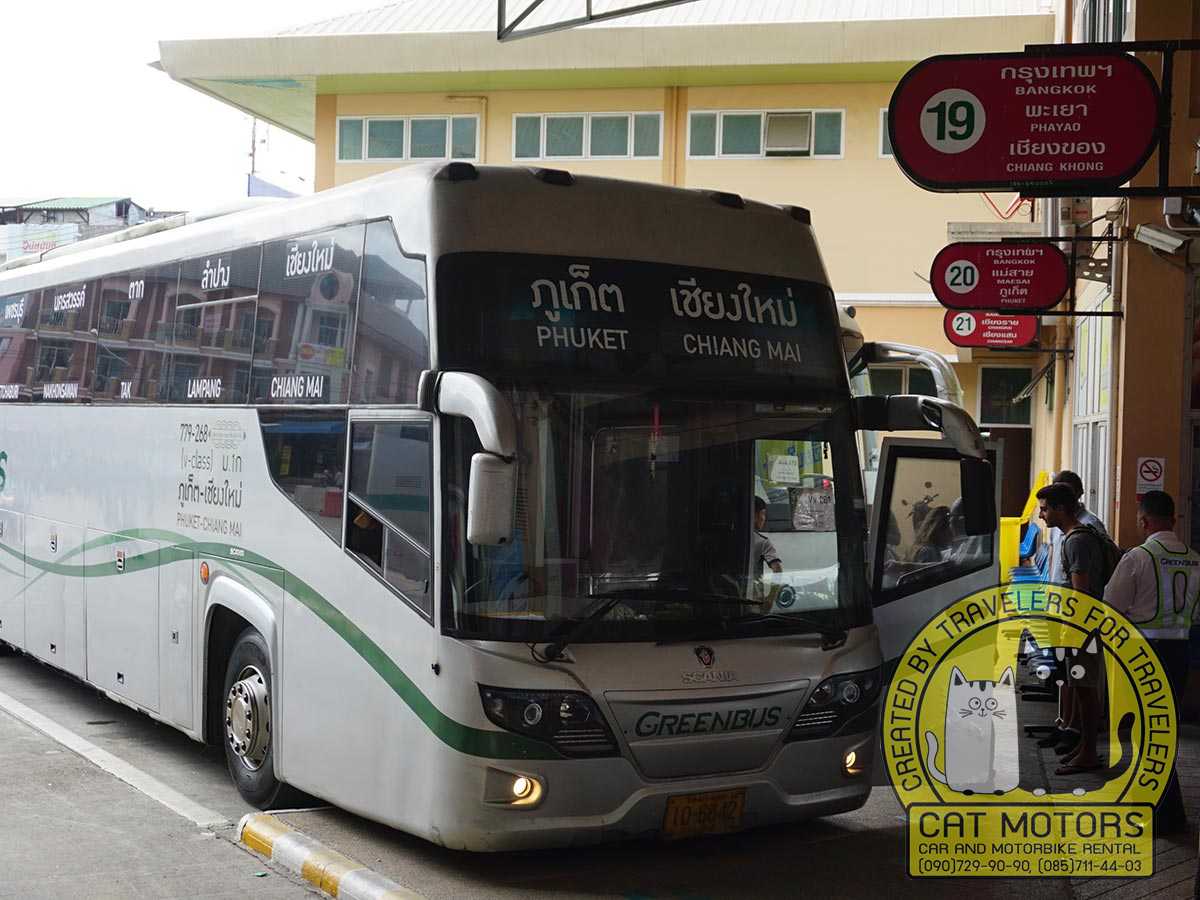
Getting around can be tough if you’re new to the area. Find your way around the busy streets to the bus station using Google Maps and GPS apps like Waze, or you can also ask locals for directions around town – just be sure to know which terminal you must go to!
Some of these bus stops are serviced by local buses (songthaew) that charge a flat fare of 15 THB per person, while Songthaews service others that charge a variable fare depending on the distance and destination.
RTC Chiang Mai Smart Bus (the blue bus) is another popular option. It’s a modern bus system operating nine routes covering the city center and the airport. This bus service charges budget-friendly prices and has a Moovit app to track the buses in real-time.
Navigation Ease: The Modern Layout Of Chiang Mai Bus Stations
The Chiang Mai Bus Station has a modern and spacious layout, with three terminals serving different buses and routes. The rows of multi-colored public seating chairs at the entrance of the bus station serve as a sign for newcomers to identify the station. You can also see the Songthaews (“Two Seater” in Thai) around Terminal 1 and the single and double-decker buses at Terminals 2 and 3.
Terminal 1 (Chang Phueak Bus Station)
Chiang Mai bus station terminal 1 is the oldest in the city, serves public transportation for local routes, and is closer to the Old City Moat. It’s definitely the smallest of the three terminals, but many think it has a certain charm to it.
Terminal 1 is really cozy and convenient. Inside, you’ll find a ticket counter right in the center and some public telephones on the walls. Plus, there’s a nice no-smoking waiting area outside.
- Don’t be surprised if you find no actual buses at Chang Phueak Bus Station since they mainly operate this public service with vans and songthaews waiting to take you to nearby stops and locations within the local city and nearby districts. Still, you may find the odd non-air-conditioned local bus ready to take you to the regular drop-off and pickup bus stops.
Because it’s surrounded by hole-in-the-wall stores offering many things to shop around for, It also has many attractions to keep you busy while waiting for your public van or songthaew transport. The mini-market stores all sell various products, from snacks to beverages.
And near Chang Phueak, you can find fast food stalls that would let your tastebuds explore the various flavors of Thai food complemented by budget-friendly menus.
Terminal 2 (Arcade Bus Terminal)
The Chiang Mai bus station terminal 2 focuses on long-distance travel to and from Chiang Mai and other parts of Thailand. And if you need it, you will find:
- Ticket counters (if you wish to purchase a ticket physically)
- Information desks (with English-speaking staff)
- Comfortable waiting areas
- Restrooms
- Luggage storage
- Many shops and restaurants
- Conveniently placed
It is located about 3 km (1.9 miles) east of the city’s center and also the proud neighbor to Terminal 3.
Terminal 2 is the place to reach destinations like Bangkok, Chiang Rai, Lampang, Mae Hong Son, Sukhothai, and Krabi, among many more. If you rock up early, be sure to explore the market showcasing many stores and restaurants just outside the station, where you can grab yummy food while waiting for your bus.
Some popular places to eat around this terminal are Dmilk Milodip Arcade 2 (a milk shop serving various flavors of fresh milk and smoothies) and Ruan Kwan Oo (a restaurant serving Chinese-style noodles and dumplings). There is also a 7-Eleven convenience store for those looking for a quick stop for some essentials.
Terminal 3 (Wat Ket Bus Station)
This terminal serves as a hub for inter-provincial buses that connect Chiang Mai with other regions of Thailand. It is located on Wat Ket Road, about 5.3 km (2.5 miles) east of Terminal 1.
It has similar facilities as Terminal 2, such as ticket counters, information desks, waiting rooms, restrooms, luggage storage, shops, restaurants, and ATMs. You can use this terminal to travel to destinations such as Phitsanulok, Phrae, Nan, Nakhon Sawan, Udon Thani, Khon Kaen, Nong Khai, and more.
You can also find essential services and stores in and around Chiang Mai bus stations terminals 2 and 3, such as pharmacies, convenience stores, banks, post offices, internet cafes, massage parlors, and more.
How to Ride the Rainbow: A Guide To Chiang Mai's Colorful Buses
Yes, you read that right. Chiang Mai’s “buses” are colorful, and each color has a different meaning. They are not really buses but songthaew, which means “two rows” in Thai. Aside from the popular tuk-tuk seen in and around town, the Songthaews have converted pickup trucks with two benches where passengers can sit in the back.
They are cheap, convenient, and fun to ride and ride a Songthaew, just wave your hand and tell the driver where you want to go.
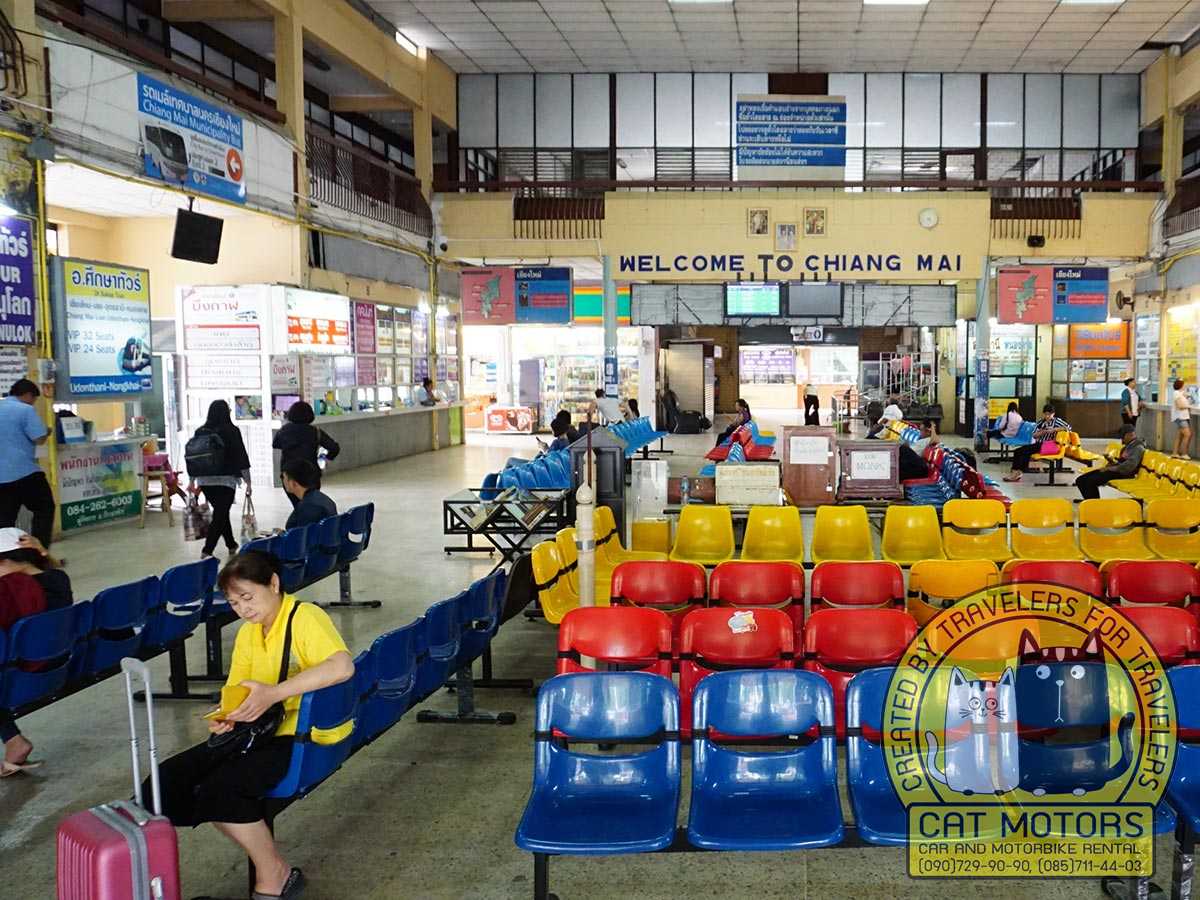
Here are the main types of songthaew you can find in Chiang Mai Province:
- Red Songthaew: Red vehicles are the most common and versatile ones. They don’t have a fixed route or timetable but operate like shared taxis. You can flag them down anywhere on the street and tell them where you want to go.
They charge around 30 Baht ($0.90) per person and are pretty popular, so expect to find a few commuters joining you on a brief trip in the same direction.
- Yellow Songthaew: These are also the most frequently seen yellow vehicles on the road that goes to and from the Arcade Bus Station, the main bus terminal in Chiang Mai. They also serve other destinations in the city’s eastern part, such as Central Festival Mall, Promenada Mall, and San Kamphaeng Hot Springs. It usually costs around 15 baht (around $0.45) per person.
- White songthaew: These are the ones that go to and from the Chang Puak Bus Station, which is another bus terminal in Chiang Mai that serves mainly local destinations within the province. They also travel to other destinations in the northern part of the city, such as Wat Phra That Doi Suthep, Chiang Mai Zoo, and Mae Rim, usually 20 baht (around $0.60) per person.
- Blue Songthaew: The blue ones go to and from the Chiang Mai International Airport. The fare is usually 40 baht (around $1.20) per person. They also serve other destinations in the southern part of the city, such as the Night Bazaar, Tha Phae Gate, and Chiang Mai Gate.
- Green Songthaew: These are the ones that go to and from Hang Dong District, which is a suburban area south of Chiang Mai. They also serve other destinations in the western part of the city, such as Nimman Road, Maya Lifestyle Shopping Center, and Chiang Mai University. The fare is usually 20 baht (around $0.60) per person.
- Orange Songthaew: These orange vehicles travel from Chiang Mai to Fang, where you can go to see the lovely Doi Ang Khang National Park. They have a fixed route and timetable and depart from Chang Phueak Bus Terminal.
You can board them at the terminal or anywhere along the route and pay a fare of 40 to 80 baht (around $1.20 to $2.40) per person, depending on the distance. They operate from 6.15 am to 6 pm and might also stop at other points of interest, such as Fang Hot Spring.
As you can see, the buses found in and around the Chiang Mai bus stations are colorful and diverse, and you can choose the one that suits your budget and needs best.
How to Buy Express Bus Tickets in Chiang Mai
Unlike their smaller, colorful Songthaew siblings, Chiang Mai’s bus stations terminals 2 & 3 are home to the bigger coaches with many options for lengthier journeys. There are many ways to order bus tickets to and from Chiang Mai province, and you can book online through various websites.
These options offer online information, including bus fares for different bus companies and routes. Please visit the bus terminals or stations to buy tickets physically, where you can choose from different types of buses, such as economy, VIP, or sleeper. Some bus companies also have their own offices or agents in the city where you can purchase tickets.
The process of boarding the bus is similar to any traditional bus route. You need to hand in your ticket and your luggage to the staff at the terminal, who will label and store your luggage on the bus. You can then find your seat on the bus and enjoy the ride. The buses usually have air conditioning, reclining seats, and sometimes snacks and drinks.
And depending on your destination and route, the bus may stop at some places along the way for restrooms or food. You must collect your luggage from the bus and exit the terminal when you arrive at your destination.
Summary
Chiang Mai Bus Station is the starting point for exploring Northern Thailand, and the three terminals cater to different buses and routes. Terminal 1 (Chang Phueak Bus Station) serves public areas within the local city, Terminal 2 (Arcade Bus Terminal) handles long-distance express routes located east of the city center, and Terminal 3 (Wat Ket Bus Station) is designated for inter-provincial travel.
The terminals are conveniently located, and many bus stops around Chiang Mai help you get around the city and its outskirts. With a modern layout, you can easily identify any Chiang Mai bus station and enjoy your journey with ease and affordability.
FAQ
The main bus station, Arcade Bus Station, is located in the eastern part of the city, approximately 3 kilometers from the city center.
While the hours may vary, the bus stations typically operate from early morning (around 5 AM) to late evening (around 11 PM). Waiting areas for visitors are available 24 hours a day.
Buses run frequently throughout the day, with the frequency varying based on the specific route and time of day. Generally, you can expect a bus every 15-30 minutes.
Yes, there are multiple routes covering different parts of Chiang Mai and its outskirts. Buses also run to other cities in Thailand.
Tickets can be purchased at the bus station’s ticket counter. Some long-distance buses also allow online booking. You can check the prices from the links we have provided in this guide.
Yes, long-distance buses connect Chiang Mai with major cities including Bangkok, Phuket, and many others.
Yes, luggage storage facilities are typically available at the bus station, though there might be a small fee.
The bus station typically includes amenities such as restrooms, waiting areas, food vendors, and sometimes, free Wi-Fi.
Yes, English is commonly spoken in tourist areas like bus stations in Chiang Mai, and signs often include English translations.
Embark on an adventure through Northern Thailand with our comprehensive travel guides, which showcase the best scenic routes and local highlights. Start by visiting our scooter rental in Chiang Mai homepage and review our terms and conditions for a smooth rental experience. With these resources, you can confidently explore mountain trails and charming villages.
Our travel advice sections offer essential tips on staying safe and enjoying your trip to the fullest. Discover the best times to visit popular attractions, experience local festivals, and handle different road conditions. These tips will make your journey richer and more enjoyable. Join us in exploring the breathtaking landscapes and vibrant culture of Northern Thailand, ensuring a safe and memorable adventure.
Cat Motors Team
Was this post useful for you?
You can rate it by clicking on a star
Average rating / 5. Vote count:
No votes so far! Be the first to rate this post.
We are sorry that this post was not useful for you!
Let us improve this post!
Tell us how we can improve this post?
- Author: Cat Motors Team
- Posted:
- Updated: August 7, 2024
- No Comments


